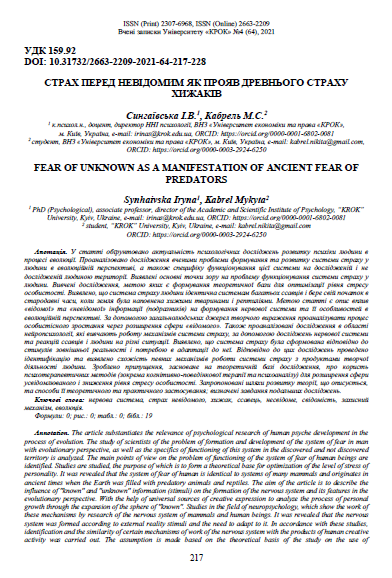FEAR OF UNKNOWN AS A MANIFESTATION OF ANCIENT FEAR OF PREDATORS
DOI:
https://doi.org/10.31732/2663-2209-2021-64-217-228Keywords:
nervous system, fear of the unknown, predator, mammal, unconscious, consciousness, defense mechanism, evolutionAbstract
The article substantiates the relevance of psychological research of human psyche development in the process of evolution. The study of scientists of the problem of formation and development of the system of fear in man with evolutionary perspective, as well as the specifics of functioning of this system in the discovered and not discovered territory is analyzed. The main points of view on the problem of functioning of the system of fear of human beings are identified. Studies are studied, the purpose of which is to form a theoretical base for optimization of the level of stress of personality. It was revealed that the system of fear of human is identical to systems of many mammals and originates in ancient times when the Earth was filled with predatory animals and reptiles. The aim of the article is to describe the influence of "known" and "unknown" information (stimuli) on the formation of the nervous system and its features in the evolutionary perspective. With the help of universal sources of creative expression to analyze the process of personal growth through the expansion of the sphere of "known". Studies in the field of neuropsychology, which show the work of these mechanisms by research of the nervous system of mammals and human beings. It was revealed that the nervous system was formed according to external reality stimuli and the need to adapt to it. In accordance with these studies, identification and the similarity of certain mechanisms of work of the nervous system with the products of human creative activity was carried out. The assumption is made based on the theoretical basis of the study on the use of psychotherapeutic methods to expand the sphere of conscious and reduce the level of stress of personality. The ways of development of the studied theory and ways of its theoretical and practical application are proposed.
Downloads
References
Hirsh J. B., Mar R. A., & Peterson J. B. Psychological Entropy: AFramework for Understanding Uncertainty-Related Anxiety. Psychological Review. Advanceonline publication. 2012. URL : https://www.researchgate.net/publication/221752816_Psychological_Entropy_A_Framework_for_Understanding_Uncertainty-Related_Anxiety.
Peterson J.: The meaning of meaning. In Wong, P. et al. (Eds.). The Positive Psychology of Meaning and Spirituality. INPM Press: Vancouver, CA. Enacting Virtual Reality: The Philosophy and Cognitive Science of Optimal Virtual Experience. URL: https://www.researchgate.net/publication/334371535_Enacting_Virtual_Reality_The_Philosophy_and_Cognitive_Science_of_Optimal_Virtual_Experience.
Peterson J. B. Peacemaking among higher-order primates. In Fitzduff, M. & Stout, C.E. (Eds.). The Psychology of Resolving Global Conflicts: From War to Peace. In Volume III, Interventions. New York: Praeger. 2006. URL : https://www.researchgate.net/publication/235336060_Peacemaking_among_higher-order_primates.
Попов С. Механизмы поведения млекопитающих: роль стресса и неопределенности среды: автореф. дис. … док. биол. наук: спец. 03.02.04 – зоология. Попов Сергей Владиленович. М., 2011. 46 с.
Douglas K. Candland, William A. Mason. Infant monkey heart rate: Habituation and effects of social substitutes. Effects of coping behavior with and without a feedback signal on stress pathology in rats. Journal of Comparative and Physiological Psychology, 77(1), pp. 22–30. DOI : https://doi.org/10.1037/h0031581.
Wingfield JC, Kitaysky AS. EndocrineResponses to Unpredictable Environmental Events Stress or Anti-Stress Hormones? Isolating the Role of Corticosterone in the Hypothalamic-Pituitary-Gonadal Transcriptomic Stress Response. URL : https://www.researchgate.net/publication/352066078_Isolating_the_Role_of_Corticosterone_in_the_Hypothalamic-Pituitary-Gonadal_Transcriptomic_Stress_Response.
Ohman A. Face the beast and fear the face: Animal and social fears as prototypes for evolutionary analyses of emotion. Psychophysiology, 1986. №23, рр. 123–145.
Archer J. Behavioral aspects of fear. In W. Sluckin (Ed.), Fear in animals and man 1979, рp. 56–85)]
Geist V. A Brief History of Human-Predator Conflicts and Potent Lessons. Proceedings of the Vertebrate Pest Conference, 2016. №27. DOI: http://dx.doi.org/10.5070/V427110421. URL : https://escholarship.org/uc/item/7bf813vq.
Sokolov E. N. The modelling properties of the nervous system. In Maltzman I., Coles K. (Eds.) Handbook of Contemporary Soviet Psychology. New York, Basic Books, 1969, pp. 670–704.
Packer C., Swanson A., Ikanda D. and Kushnir H. Fear of darkness, the full moon and the nocturnal ecology of African lions. PLoS ONE 2011. №6(7): e22285. DOI:10.1371 /journal.pone.0022285.
Sagan C. The dragons of Eden: Speculations on the evolution of human intelligence. London: Hodder & Stoughton. 1977.
Кабрель М., Сингаївська І. Усвідомлення архетипу містичної співучасті як чинник розвитку особистості. Юнгіанське консультування: теорія і практика, 2021. URL : https://conf.krok.edu.ua/YUK/YUK2021/paper/view/653.
Pennebaker James W. “Writing about Emotional Experiences as a Therapeutic Process."Psychological Science , 1997, vol. 8, no. 3, 1997, pp. 162-166.
Ohman A., Mineka S. Fears, Phobias, and Preparedness: Toward an Evolved Module of Fear and Fear Learning. Psychological Review. 2001, Vol. 108, No. 3, 483–522.
Bernard F. Batto. Slaying the Dragon: Mythmaking in The Biblical Tradition. Louisville, Kentucky: Westminster/John Knox Press, 1992. 232 pp.
Montardy Q., Kwan W. C., Mundinano I. C. et al. Mapping the neural circuitry of predator fear in the nonhuman primate. Brain Struct Funct. 2021. №226, pp. 195–205.
Isbell L. Snakes as agents of evolutionary change in primate brains. Journal of Human Evolution. 2006. №51, рp. 1–35.
MacLean, Paul D. "The Triune Brain in Conflict. Psychotherapy and Psychosomatics. 1997. №28, no. 1/4, рр. 207-20.



